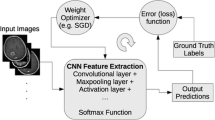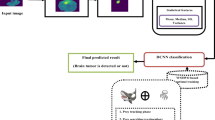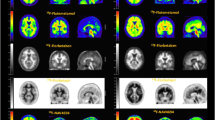Abstract
Brain white matter hyperintensities (WMHs) are linked to increased risk of cerebrovascular and neurodegenerative diseases among the elderly. Consequently, detection and characterization of WMHs are of significant clinical importance. We propose a novel approach for WMH segmentation from multi-contrast MRI where both voxel-based and lesion-based information are used to improve overall performance in both volume-oriented and object-oriented metrics. Our segmentation method (AMOS-2D) consists of four stages following a “generate-and-test” approach: pre-processing, Gaussian white matter (WM) modelling, hierarchical multi-threshold WMH segmentation and object-based WMH filtering using support vector machines. Data from 28 subjects was used in this study covering a wide range of lesion loads. Volumetric T1-weighted images and 2D fluid attenuated inversion recovery (FLAIR) images were used as basis for the WM model and lesion masks defined manually in each subject by experts were used for training and evaluating the proposed method. The method obtained an average agreement (in terms of the Dice similarity coefficient, DSC) with experts equivalent to inter-expert agreement both in terms of WMH number (DSC = 0.637 vs. 0.651) and volume (DSC = 0.743 vs. 0.781). It allowed higher accuracy in detecting WMH compared to alternative methods tested and was further found to be insensitive to WMH lesion burden. Good agreement with expert annotations combined with stable performance largely independent of lesion burden suggests that AMOS-2D will be a valuable tool for fully automated WMH segmentation in patients with cerebrovascular and neurodegenerative pathologies.








Similar content being viewed by others
References
Anbeek, P., Vincken, K. L., van Osch, M. J., Bisschops, R. H., & van der Grond, J. (2004a). Probabilistic segmentation of white matter lesions in mr imaging. NeuroImage, 21(3), 1037–1044.
Anbeek, P., Vincken, K. L., van Osch, M. J., Bisschops, R. H., & van der Grond, J. (2004b). Automatic segmentation of different-sized white matter lesions by voxel probability estimation. Medical Image Analysis, 8(3), 205–215.
Ashburner, J., & Friston, K. J. (2005). Unified segmentation. NeuroImage, 26, 839–851.
Caligiuri, M. E., Perrotta, P., Augimeri, A., Rocca, F., Quattrone, A., & Cherubini, A. (2015). Automatic detection of white matter hyperintensities in healthy aging and pathology using magnetic resonance imaging: a review. Neuroinformatics, 13(3), 261–276.
Carmona, E. J., Rincón, M., García-Feijoó, J., & Martínez-de-la Casa, J. M. (2008). Identification of the optic nerve head with genetic algorithms. Artificial Intelligence in Medicine, 43(3), 243–259.
Chang, C.-C., & Lin, C.-J. (2011) LIBSVM : a library for support vector machines. ACM Transactions on Intelligent Systems and Technology, 2. doi:10.1145/1961189.1961199.
Damangir, S., Manzouri, A., Oppedal, K., Carlsson, S., Firbank, M. J., Sonnesyn, H., Tysnes, O., O’Brien, J. T., Beyer, M. K., Westman, E., Aarsland, D., Wahlund, L., & Spulber, G. (2012). Multispectral MRI segmentation of age related white matter changes using a cascade of support vector machines. Journal of the Neurological Sciences, 322, 211–216.
de Boer, R., van der Lijn, F., Vrooman, H. A., & Vernooij, M. W. (2007). Automatic segmentation of brain tissue and white matter lesions in mri. In ISBI: IEEE.
Fedorov, A., Beichel, R., Kalpathy-Cramer, J., Finet, J., Fillion-Robin, J., Pujol, S., Bauer, C., Jennings, D., Fennessy, F., Sonka, M., Buatti, J., Aylward, S., Miller, J., Pieper, S., & Kikinis, R. (2012). 3d slicer as an image computing platform for the quantitative imaging network. Magnetic Resonance Imaging, 30(9), 1323–1341.
Fischl, B., Salat, D. H., Busa, E., Albert, M., Dieterich, M., Haselgrove, C., van der Kouwe, A., Killiany, R., Kennedy, D., Klaveness, S., Montillo, A., Makris, N., Rosen, B., & Dale, A. M. (2002). Whole brain segmentation and automated labeling of neuroanatomical structures in the human brain. Neuron, 33(3), 341–355.
García-Lorenzo, D., Francis, S., Narayanan, S., Arnold, D. L., & Collins, D. L. (2013). Review of automatic segmentation methods of multiple sclerosis white matter lesions on conventional magnetic resonance imaging. Medical Image Analysis, 17(1), 1–18.
Geremia, E., Clatz, O., Menze, B. H., Konukoglu, E., Criminisi, A., & Ayache, N. (2011). Spatial decision forests for ms lesion segmentation in multi-channel magnetic resonance images. NeuroImage, 57(2), 378–390.
Hall, M. (1998). Correlation-based Feature Subset Selection for Machine Learning. Technical report: Department of Computer Science, University of Waikato, Hamilton, New Zealand.
Hall, M., Eibe, F., Holmes, G., Pfahringer, B., Reutemann, P., & Witten, I. H. (2009). The WEKA data mining software: an update. SIGKDD Exploration Newsletter, 11(1), 10–18. doi:10.1145/1656274.1656278.
Khademi, A., Venetsanopoulos, A., & Moody, A. R. (2012). Robust White Matter Lesion Segmentation in FLAIR MRI. IEEE Transactions on Biomedical Engineering, Institute of Electrical & Electronics Engineers (IEEE), 59(3), 860–871.
Lao, Z., Shen, D., Liu, D., Jawad, A. F., Melhem, E. R., Launer, L. J., Bryan, R. N., & Davatzikos, C. (2008). Computer-assisted segmentation of white matter lesions in 3D mr images using support vector machine. Academic Radiology, 15(3), 300–313.
Lladó, X., Oliver, A., Cabezas, M., Freixenet, J., Vilanova, J. C., Quiles, A., Valls, L., Ramió-Torrentí, L., & Rovira, L. (2012). Segmentation of multiple sclerosis lesions in brain mri: A review of automated approaches. Information Sciences, 186(1), 164–185.
Lyksborg, M., Larsen, R., Sørensen, P., Blinkenberg, M., Garde, E., Siebner, H., & Dyrby, T. (2012). Segmenting Multiple Sclerosis Lesions Using a Spatially Constrained K-Nearest Neighbour Approach, volume 2, (pp. 156–163).
Moisy, F. (2012). EzyFit Toolbox. A free curve fitting toolbox for Matlab. Version 2.41. http://www.fast.u-psud.fr/~moisy/ml/index.php.
Ong, K. H., Ramachandram, D., Mandava, R., & Shuaib, I. L. (2012). Automatic white matter lesion segmentation using an adaptive outlier detection method. Magnetic Resonance Imaging, Elsevier BV, 30(6), 807–823.
Ramirez, J., Gibson, E., Quddus, A., Lobaugh, N., Feinstein, A., Levine, B., Scott, C., Levy-Cooperman, N., Gao, F., & Black, S. (2011). Lesion Explorer: A comprehensive segmentation and parcellation package to obtain regional volumetrics for subcortical hyperintensities and intracranial tissue. NeuroImage, 54(2), 963–973.
Rincón, M., Bachiller, M., & Mira, J. (2005). Knowledge modeling for the image understanding task as a design task. Expert Systems with Applications, 29(1), 207–217.
Schmidt, P., Gaser, C., Arsic, M., Buck, D., Förschler, A., Berthele, A., Hoshi, M., Ilg, R., Schmid, V. J., Zimmer, C., Hemmer, B., & Mühlau, M. (2012). An automated tool for detection of flair-hyperintense white-matter lesions in multiple sclerosis. NeuroImage, 59(4), 3774–3783.
Seghier, M. L., Ramlackhansingh, A., Crinion, J., Leff, A. P., & Price, C. J. (2008). Lesion identification using unified segmentation-normalisation models and fuzzy clustering. NeuroImage, Elsevier BV, 41(4), 1253–1266.
Selnes, P., Grambaite, R., Rincon, M., Bjornerud, A. Gjerstad, L., Hessen, E., Auning, E., Johansen, K., Due-Tønnessen, P., Vegge, K., Almdahl, I., Bjelke, B. and Fladby, T. (2015) Hippocampal complex atrophy in post-stroke and mild cognitive impairment. Journal of Cerebral Blood Flow and Metabolism. (accepted for publication, 2015).
Selnes, P., et al. (2013). Diffusion tensor imaging surpasses cerebrospinal fluid as predictor of cognitive decline and medial temporal lobe atrophy in subjective cognitive impairment and mild cognitive impairment. Journal of Alzheimer's Disease, 33(3), 723–736.
Shenshen, S. (2010). Automatic Segmentation of White Matter Lesions from MRI Data. Germany: LAP Lambert Academic Publishing.
Shuangxi, J., Changqing, Y., Fan, L., Wei, S., Jue, Z., Yining, H., & Jing, F. (2013). Automatic segmentation of white matter hyperintensities by an extended FitzHugh & nagumo reaction diffusion model. Journal of Magnetic Resonance Imaging, 37(2), 1522–2586. doi:10.1002/jmri.23836.
Sweeney, E. M., Shinohara, R. T., Shiee, N., Mateen, F. J., Chudgar, A. A., Cuzzocreo, J. L., Calabresi, P. A., Pham, D. L., Reich, D. S., & Crainiceanu, C. M. (2013). OASIS is Automated Statistical Inference for Segmentation, with applications to multiple sclerosis lesion segmentation in MRI. NeuroImage: Clinical, Elsevier BV, 2, 402–413.
Sweeney, E. M., Vogelstein, J. T., Cuzzocreo, J. L., Calabresi, P. A., Reich, D. S., Crainiceanu, C. M. and Shinohara, R. T. (2014). A Comparison of Supervised Machine Learning Algorithms and Feature Vectors for MS Lesion Segmentation Using Multimodal Structural MRI. Draganski, B. (ed.) PLoS ONE, Public Library of Science (PLoS), Vol. 9(4).
Wang, R., Li, C., Wang, J., Wei, X., Li, Y., Hui, C., Zhu, Y., & Zhang, S. (2014). Automatic segmentation of white matter lesions on magnetic resonance images of the brain by using an outlier detection strategy. Magnetic Resonance Imaging, 32(10), 1321–1329. doi:10.1016/j.mri.2014.08.010.
Wardlaw, J. M., et al. (2013). Neuroimaging standards for research into small vessel disease and its contribution to ageing and neurodegeneration. The Lancet Neurology, 12, 822–838.
Zijdenbos, A.P., Dawant, B.M., Margolin, R.A. and Palmer, A.C. (1994). Morphometric analysis of white matter lesions in MR images: method and validation IEEE Trans Med Imaging, Vol. 13, No. 4.
Acknowledgements
We acknowledge the funding of different institutions: two grants from Iceland, Liechtenstein and Norway through the EEA Financial Mechanism, supported and coordinated by Universidad Complutense de Madrid (Calls UCM-EEA-ABEL-02-2009 and ABEL-CM-01-2013) and a grant from UNED for the training of research staff (Call 2012).
Author information
Authors and Affiliations
Corresponding author
Ethics declarations
Disclosure Statement
The authors declare that there are neither actual nor potential conflicts of interest.
Appendix
Appendix
Evaluation of segmentations results compared with the gold standard obtained from three experts using the “majority vote” rule.
Rights and permissions
About this article
Cite this article
Rincón, M., Díaz-López, E., Selnes, P. et al. Improved Automatic Segmentation of White Matter Hyperintensities in MRI Based on Multilevel Lesion Features. Neuroinform 15, 231–245 (2017). https://doi.org/10.1007/s12021-017-9328-y
Published:
Issue Date:
DOI: https://doi.org/10.1007/s12021-017-9328-y




